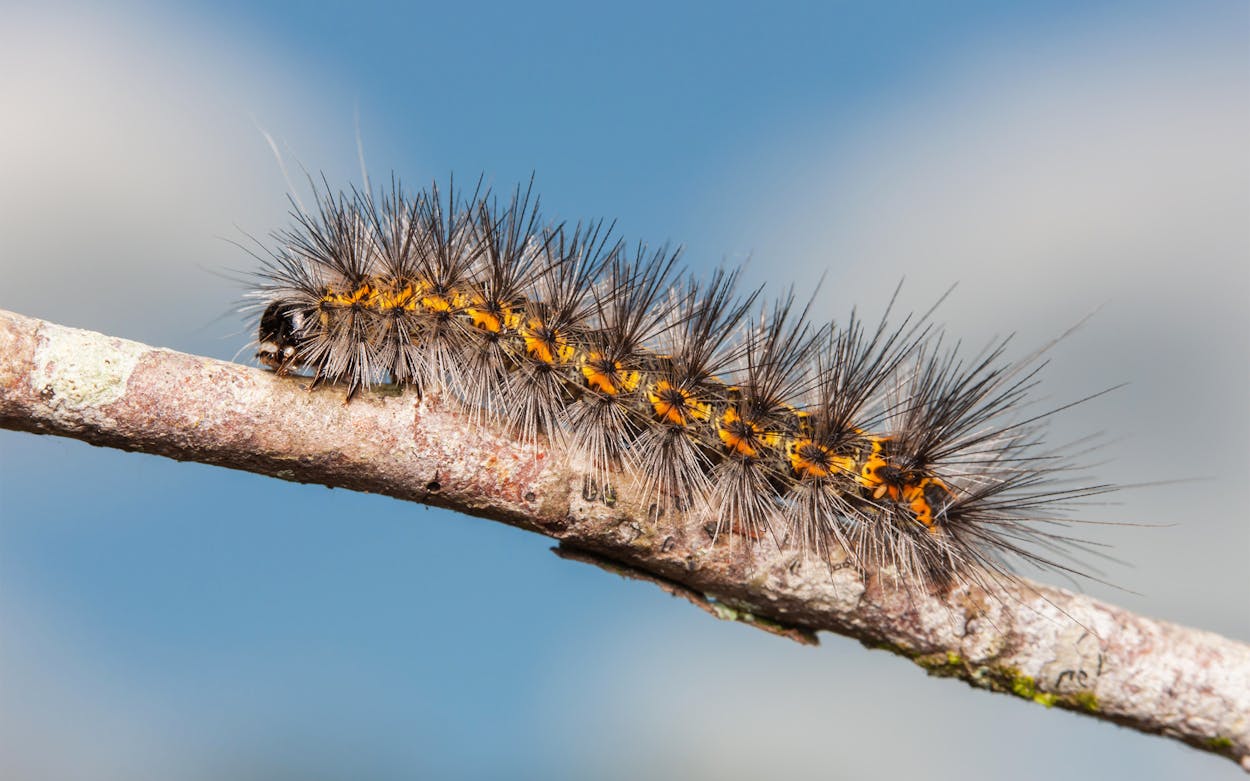Ah, springtime in Texas. Perfect weather for margaritas on the patio, pollen-induced allergy attacks, and, in many backyard gardens, sidewalks, and roads across the state, an invasion of fuzzy black caterpillars.
Often called woolly bear or salt marsh caterpillars, these bristly critters often crawl out of their winter hiding spots this time of year. With many flowers and plants in full bloom across the state, spring is an ideal time for caterpillars to gorge themselves on food, gathering the energy they’ll need to weave a cocoon and undergo their transformation into moths later in the season. Rather than a single species, these caterpillars are a large group belonging to the subfamily Arctiinae, which includes more than six thousand species. “When people see a fuzzy caterpillar like that, they call it a woolly bear or salt marsh,” says Wizzie Brown, a senior extension program specialist at Texas A&M’s AgriLife Extension Service, “but there are multiple caterpillars that look like that.”
They come in many colors, from black and brown to orange and yellow. All turn into moths—often quite beautiful ones—in late spring. One of the most common species in Texas is Estigmene acrea, which transforms into a striking white, black, and gold moth.
These insects live in all parts of Texas and many other parts of the U.S. (there’s even a woolly bear festival in northern Ohio), but have spotty populations, Brown says. Some areas may see a bunch this time of year, while other areas may have less, but Brown reports that she’s received a lot of calls this year from Houston and Central Texas. “It depends on environmental conditions,” Brown says. “What happens in one area may not happen in another area.”
A lot of that comes down to mid-winter weather. The caterpillars hatch from eggs late in the year and find a warm place to hunker down for the colder months. Because we had a fairly mild winter, Brown says, more likely survived to spring. Now, those bugs are waking up and filling up before settling into the pupal stage. (That’s the term for the transitional state during which a caterpillar is holed up in its cocoon. It becomes goo for a while before emerging as a moth.)
There’s also an old myth that striped woolly bear caterpillars—a particular species with orange and black stripes—can predict the severity of a winter. As the tale goes, if you see them in the fall, you can gauge the length of winter based on the width of the caterpillar’s orange stripe; in most variations of the story, a blacker caterpillar predicts a harsher or colder winter. But this charming lore has no basis in reality, Brown says—nor is this species common in Texas, since it prefers a cooler climate.
The several species of fuzzy caterpillars transform into different moths. Salt marsh caterpillars turn into white moths with black spots, and woolly bear caterpillars turn into tiger moths, which are orange with black spots. Their fuzzy hairs, called setae, help the caterpillars survive winter, and will wrap around their bodies to help form the pupa stage. They also ward off predators, as the birds and bats that eat the adult moths don’t like the spiky texture of the caterpillars.
They feed on leafy greens, and can cause havoc on a vegetable garden, Brown says, but most low-impact pesticides will have little impact on the larger caterpillars. Instead, she suggests wearing gloves and removing them by hand.
Although they may look fearsome, Brown says, they are not poisonous. However, they may cause mild skin irritation for some people, and other species of fuzzy caterpillars, such as the Southern flannel moth, are venomous. If you encounter a caterpillar and aren’t sure what kind it is or whether you should pick it up, Brown has a simple rule of thumb: “Just don’t do it.”






